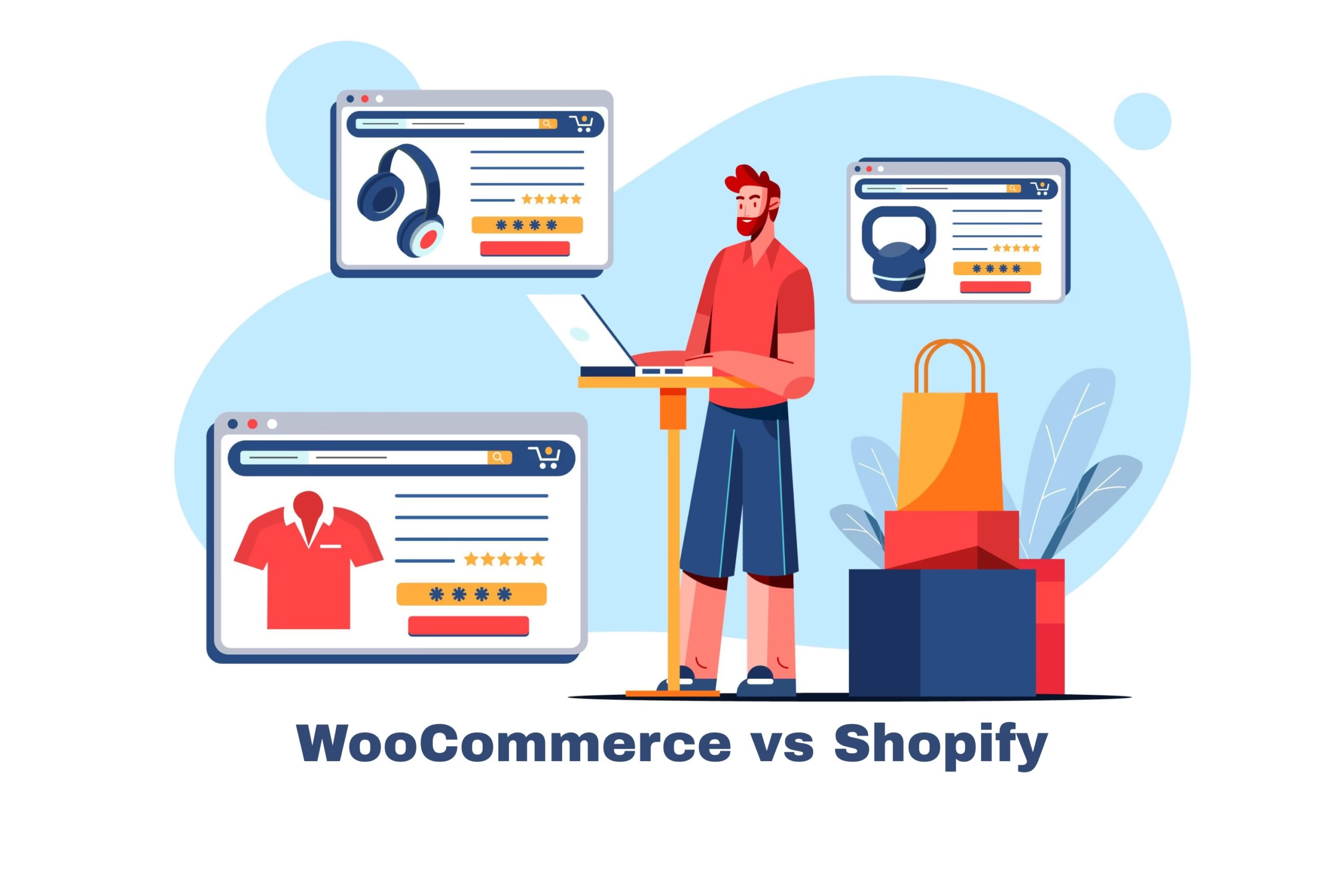In today’s digital age, establishing an online store is crucial for businesses looking to expand their reach and maximize revenue. With numerous eCommerce platforms available, choosing the right one can be overwhelming. WooCommerce vs Shopify are among the most widely used solutions. Both platforms offer robust features, but they cater to different needs and business models.
While Shopify provides a user-friendly, all-in-one solution, WooCommerce offers flexibility and control over customization. This blog will explore their unique strengths, differences, and why WooCommerce may be the best ecommerce platform for businesses seeking a scalable and customizable eCommerce experience.
Key Takeaways
1. WooCommerce and Shopify cater to different business needs, with WooCommerce offering greater customization and Shopify providing an easy-to-use solution.
2. Shopify is ideal for beginners who need a hassle-free setup, while WooCommerce suits businesses that require more control over their online store.
3. Pricing, flexibility, and scalability are key factors to consider when selecting an eCommerce platform.
4. WooCommerce’s integration with WordPress provides unmatched SEO and content marketing advantages.
See How DigiCompanions Can Drive More Traffic to Your Website
Website Designing – Create user-first, high-converting websites with sleek, responsive designs that reflect your brand and boost engagement.
Digital Marketing – Maximize ROI with tailored paid media strategies and growth-driven campaigns.
Table of Contents
Introduction to WooCommerce and Shopify
Before diving into the WooCommerce vs Shopify comparison, let’s briefly introduce these two platforms:
- WooCommerce is a free, open-source plugin for WordPress that allows users to create and manage an online store. Since it operates within WordPress, it provides complete control over customization, functionality, and content management.
- Shopify is a fully hosted best ecommerce platform that simplifies store setup and management. It is subscription-based and includes hosting, security, and built-in features, making it ideal for users who prefer a streamlined approach.
Ease of Use
Shopify: A Beginner-Friendly Solution
Shopify is designed for ease of use. It provides a drag-and-drop interface, allowing users to set up an online store quickly, even with no technical expertise. Since Shopify handles hosting, security, and maintenance, it eliminates many of the technical aspects of running an eCommerce store.
WooCommerce: Flexibility with a Learning Curve
WooCommerce requires some technical knowledge as it operates within WordPress. Users need to handle hosting, updates, and security themselves or through a managed hosting provider. However, for those familiar with WordPress, WooCommerce offers a seamless experience with extensive control over store design and functionality.
Customization and Flexibility
WooCommerce: Unlimited Customization
WooCommerce stands out in terms of customization. Since it is open-source, users have complete access to modify the code, install plugins, and adjust settings to fit their unique business needs.
- WordPress themes come in thousands of versions, both free and premium.
- Over 50,000+ WordPress plugins enable advanced functionalities like SEO, analytics, automation, and CRM.
- Developers can create custom features and integrations.
Shopify: Customization with Limitations
While Shopify offers customization options, it is limited to Shopify’s ecosystem. Users can modify themes, but they are restricted to Shopify’s coding language, Liquid. Additionally, many advanced features require paid apps, increasing costs over time.
Pricing and Cost-effectiveness
WooCommerce: Cost-efficient and Scalable
WooCommerce itself is free, but costs include hosting, domain, and premium themes or plugins. However, businesses have full control over expenses, allowing them to scale without recurring fees for essential features.
Shopify: Fixed Pricing with Add-On Costs
Shopify has a monthly subscription fee. While hosting and security are included, third-party apps and transaction fees can make Shopify more expensive in the long run.
SEO and Marketing Capabilities
WooCommerce: Superior SEO Performance
WooCommerce, powered by WordPress, provides advanced SEO capabilities. Users can leverage SEO plugins like Yoast SEO, optimize site structure, and create content-rich blogs to drive organic traffic.
Shopify: SEO Limitations
Shopify includes basic SEO settings but lacks advanced customization. URL structures and metadata are not as flexible as WooCommerce, limiting deep SEO optimization.
Payment Gateways and Transaction Fees
WooCommerce: No Additional Transaction Fees
WooCommerce supports all major payment gateways without additional transaction fees. Businesses using PayPal, Stripe, or local payment providers do not have to worry about extra charges beyond standard processing fees.
Shopify: Additional Transaction Fees Apply
Shopify charges an additional transaction fee (0.5% to 2%) if you do not use Shopify Payments. This can add up for businesses with high transaction volumes.
Scalability and Growth Potential
WooCommerce: Scalable for Any Business Size
Since WooCommerce is self-hosted, businesses can scale as needed by upgrading hosting plans. It supports unlimited products, custom databases, and high-traffic handling.
Shopify: Scales Easily but With Pricing Constraints
Shopify scales well, but costs increase significantly for high-growth businesses, especially when using advanced features or custom integrations.
Security and Support
WooCommerce: User-Controlled Security
WooCommerce users are responsible for security measures, such as SSL certificates, backups, and malware protection. However, managed hosting solutions simplify this aspect.
Shopify: Built-in Security
Shopify provides automatic SSL, PCI compliance, and backups, reducing security concerns for users.
Final Thoughts
Both WooCommerce and Shopify have their strengths, making them great choices for different types of businesses. Shopify is ideal for those who want a hassle-free experience, while WooCommerce is perfect for businesses that need flexibility, customization, and control.
If you prioritize SEO, customization, scalability, and cost control, WooCommerce emerges as the best ecommerce platform for businesses looking for long-term growth.
Transform your online presence with a custom website designed by experts at Digicompanions. We focus on delivering responsive, visually appealing websites that align with your business goals. Ready to get started? Contact us now and let’s create a website that truly represents your brand!
Quick Comparison Table:
| Feature | Shopify | WooCommerce |
|---|---|---|
| Ease of Use | ⭐⭐⭐⭐⭐ | ⭐⭐⭐ |
| Customizability | ⭐⭐⭐⭐ | ⭐⭐⭐⭐⭐ |
| Cost (initial/setup) | Medium | Low to Medium |
| Cost (monthly) | Starts ~$29/mo | Varies (hosting + plugins) |
| SEO Capabilities | Good | Excellent |
| Tech Skill Required | Low | Medium to High |
| Best For | Quick Launch | Full Control |
FAQs
Yes, WooCommerce is generally more cost-effective since it has no monthly fees. However, costs vary based on hosting, themes, and plugins.
WooCommerce, because of its WordPress foundation, provides better SEO flexibility and tools compared to Shopify.
Yes, you can migrate your store using tools like Cart2Cart or manual export/import methods.
When choosing between WooCommerce vs Shopify, note that Shopify requires minimal technical skills. WooCommerce doesn’t need coding knowledge either, but familiarity with WordPress can be helpful.
WooCommerce offers more scalability and flexibility, making it a better long-term solution for growing businesses.
WooCommerce offers greater customization because it’s open-source and built on WordPress, making it ideal if you’re looking for the best ecommerce platform for full design control.
WooCommerce, being integrated with WordPress, is the best ecommerce platform for blogging and SEO-driven content strategies.
When comparing WooCommerce vs Shopify, Shopify is easier to set up for beginners because it offers a fully hosted, plug-and-play experience. WooCommerce requires WordPress installation and hosting setup, which may need some technical skills.


